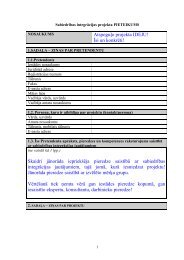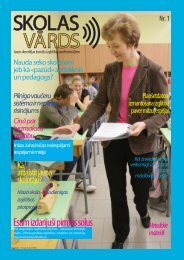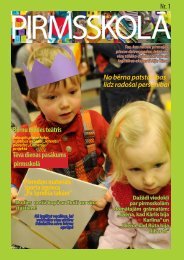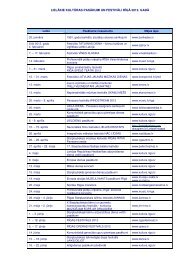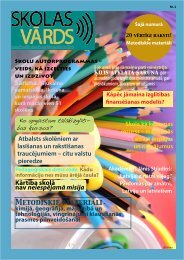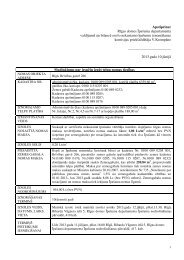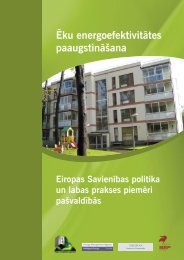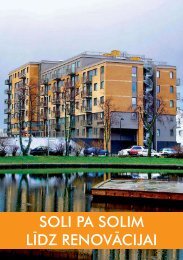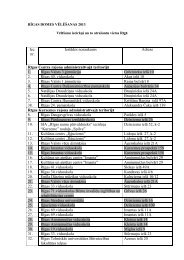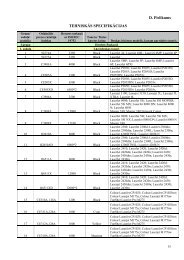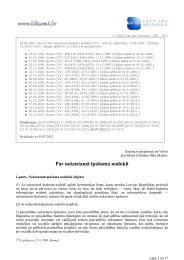Riga - European Capital of Culture 2014 candidate
Riga - European Capital of Culture 2014 candidate
Riga - European Capital of Culture 2014 candidate
- No tags were found...
You also want an ePaper? Increase the reach of your titles
YUMPU automatically turns print PDFs into web optimized ePapers that Google loves.
Central MarketLatvian National OperaCentral Market<strong>Riga</strong>’s Central Market is the largest market in the Baltics and one <strong>of</strong> the largest open typemarkets both in Europe and the world. It was unveiled in 1930, and the five market pavilionscomprised the largest construction object in Latvia after the First World War. Thefunction <strong>of</strong> the Central Market has not changed up to the present day – it is the largestand most popular place for shopping and trading. Farmers from the whole <strong>of</strong> Latvia <strong>of</strong>fertheir products in the market pavilions and the open market territory – vegetables, berries,fruit, meat, dairy products and other countryside goods. The Central Market is alsoinvolved in art activities – this year, the annual “Art Days” were organised here with anartists’ campaign on the ro<strong>of</strong> <strong>of</strong> the meat pavilion, poetry readings, sale <strong>of</strong> artistic itemsand lectures by pr<strong>of</strong>essionals about contemporary art.Daugava embankmentIn the 14 th century, the embankment <strong>of</strong> the Daugava became the city’s main harbour.With changing times, the harbour has moved further away from the city centre, but theembankment now serves for recreational purposes. The embankment <strong>of</strong> the Daugavahas also entered history as one <strong>of</strong> the symbols <strong>of</strong> the Singing Revolution, which broughttogether hundreds <strong>of</strong> thousands <strong>of</strong> people for peaceful demonstrations demandingrestoration <strong>of</strong> national independence. Every year military parades take place here onNational Independence Day, but in the evening, people converge to marvel at the fireworkdisplay. Hundreds <strong>of</strong> thousands <strong>of</strong> people celebrated the country’s accession tothe <strong>European</strong> Union on the embankment, where various city festival grand concerts havetaken place. Boat trips leave from several quayside stopping points, <strong>of</strong>fering anyoneinterested a view <strong>of</strong> <strong>Riga</strong> from the River Daugava.Latvian National OperaThe ‘White House’ <strong>of</strong> <strong>Riga</strong>, as the opera is popularly known, was built in 1863. At thetime it was called the City’s First Theatre, or German Theatre, and it was built accordingto the project implemented by St. Petersburg’s architect, Ludwig Bohnstedt. Today, theNew Hall has been added to the historical building <strong>of</strong> the Latvian National Opera. Duringone season 200 performances are staged at the Opera. During one year an average <strong>of</strong>6 new productions are prepared, retaining a proportionate amount <strong>of</strong> opera and balletperformances. For two weeks in June, the annual <strong>Riga</strong> Opera Festival takes place, whichhas been organised since 1998, as a resume <strong>of</strong> the former season. During the festival,the previous season’s new productions and most significant performances are usuallydemonstrated, and a large symphonic work performed.Arēna Rīga(EAA) since November 2005. EAA unites more than 20 <strong>European</strong> arenas, and its objectiveis to promote a unified exchange <strong>of</strong> information among the arenas <strong>of</strong> Europe aboutevents, legislation, novelties in the technology field and changes in the market situation.The Arena was opened in 2006, its capacity – 14,500 seats, total area 22,568 m 2 , arenaarea – 33 x 63 metres.Mežaparks Open-Air StageThe Mežaparks Open-Air Stage was built in 1955. Although several reconstructions andadditions to the stage have been implemented over time, it has retained its original visualimage and is suitable for organising vast cultural and recreational events – uniting upto 20,000 singers and close to 100,000 audience members in the Genereal Song andDance Celebration. Rock concerts and other popular events take place on the stage.In 2008, Phase 1 <strong>of</strong> the stage reconstruction was completed and Phase 2 should becompleted in a couple <strong>of</strong> years, during which it is planned to widen the stage and audiencesection, as well as considerably improve the area surrounding the stage. The parksurrounding the stage is already suitable for public sports and recreational pastimes andchildren’s activities – the century old Zoo is located next door.<strong>Riga</strong> Art Space“<strong>Riga</strong> Art Space” is a multifunctional exhibition hall backed by <strong>Riga</strong> City Council, whosemain task is to promote and support contemporary visual art, both at local and internationallevel. “<strong>Riga</strong> Art Space” operates on parallel levels within the frameworks <strong>of</strong> severalprogrammes. The basis <strong>of</strong> the large exhibition programme is formed by “<strong>Riga</strong> ArtSpace” and guest curators, ensuring at least 5 large art displays per year. Within theframework <strong>of</strong> this programme, each display can be viewed for 2 months. When planningthis programme, parity between hosting travelling exhibitions and the creation <strong>of</strong> originalart products is observed. The exhibition programme “Intro”, dedicated to the Baltic andEastern <strong>European</strong> national art space, takes place separately in a small exhibition roomand ensures a turnover <strong>of</strong> 12 displays per year. This programme compensates for thelack <strong>of</strong> non-commercial art galleries in <strong>Riga</strong> and special emphasis is placed on providingopportunities for the debuts <strong>of</strong> new artists or art curators.The “Public Forum” is a programme that creates cooperation opportunities betweenrepresentatives from creative pr<strong>of</strong>essions and those working in other sectors, promotessocial activity, expressions <strong>of</strong> procedural art and art in the public arena. 4 bigger interdisciplinaryart events per year are planned within this programme and smaller, regularcycles <strong>of</strong> thematic events. “Public Forum” will <strong>of</strong>fer concerts, literary and theatrical artevents, cinema and video art events, public readings and meetings with the creativeintelligentsia from Latvia and abroad.Mežaparks Open-Air Stage<strong>Riga</strong> Art SpaceArena “<strong>Riga</strong>”The technical equipment and level <strong>of</strong> service provided by Arēna Rīga complies with thetop class needs <strong>of</strong> the international entertainment industry, which, with the participation<strong>of</strong> the world’s most sought-after stage artists, musicians and sportsmen, can bring togetheraudiences <strong>of</strong> several thousand people. The Arena provides event organisers theopportunity <strong>of</strong> <strong>of</strong>fering Latvian audiences the world’s most sought after shows, performancesand concerts. Arēna Rīga has been a member <strong>of</strong> the <strong>European</strong> Arena AssociationThe aim <strong>of</strong> “<strong>Riga</strong> Art Space” educational programme is to promote understanding insociety about contemporary art processes, by organising lectures, meetings with artists,providing guide services, cooperating with educational establishments and art schools,as well as <strong>of</strong>fering visual art activities for individuals and groups. “<strong>Riga</strong> Art Space” was<strong>of</strong>ficially opened in 2008. The Large Hall is 1700 m 2 , the Intro Hall 150 m 2 and the educationalroom 70 m 2 .156 157



